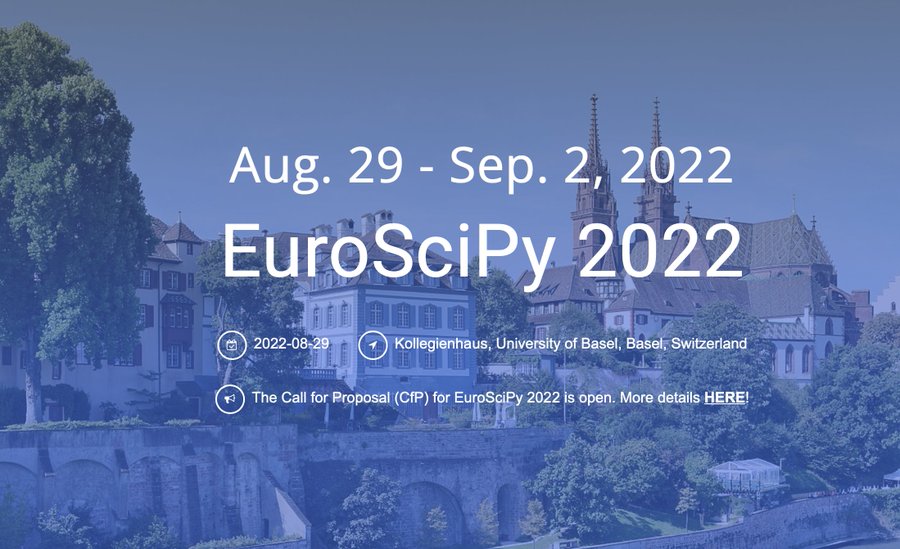EuroSciPy 2022
After a conference one usually comes back with something new, something valuable. EuroSciPy is a cross-disciplinary conference on python in science where users and developers of scientific tools, as well as academic research, and state-of-the-art industry come together. My backpack contained many topics like:
- current challenges in sciences and industry and their state-of-the-art solution
- new python packages and their applications.
Rather than focusing on the technical aspects, I like to share some experiences and ideas I brought home, which are less often part of articles and books.
Decision making under uncertainty
After the COVID-19 pandemic restrictions, it was really nice to give a talk in front of a real audience and have an in-person exchange with other experts again. In particular after two years of virtual talks only, I was impressed talking in front of a full lecture hall.
In the talk “Decision making under uncertainty” I demonstrated how we can translate real world problems into mathematical optimization problems involving uncertainty, which are called stochastic programs. A stochastic program finds a decision which is best for all given data instances of the problem. This contrasts classical deterministic optimization, in which all problem parameters are assumed to be known exactly. Because in real world decision problems not all information is available at the time when the decision has to be made, stochastic programming found numerous applications in a broad range of areas. Moreover, I explained the benefit of stochastic programming based on examples, demonstrating what can go wrong or how much money is lost when not taking uncertainty into account.
One of the shown examples was the newsvendor problem, in which a newspaper vendor must decide how many newspapers to order, facing uncertain demand and knowing that unsold copies are worthless at the end of the day. As a two-stage stochastic program the newsvendor problem can be formulated as follows:
\[ \begin{array}{rl} \min & cx \quad+\sum_{\omega\in\Omega}Pr[\omega]\big[-qy_\omega -rw_\omega \big] \\ \mathrm{s.t.} & y_\omega \leq d_\omega \;\forall\;\omega\in\Omega\\ & y_\omega + w_\omega \leq x\;\forall\;\omega\in\Omega\\ & y_\omega,w_\omega\geq0\;\forall\;\omega\in\Omega \\ & 0 \leq x \leq u \end{array} \]
Here, \(x\) is the number of newspapers ordered, \(y\) is the number of newspapers sold, \(w = x - y\) is the number of newspapers returned to the publisher, \(d_w\) denotes the realization of the random demand in scenario \(\omega\in \Omega\), \(u\) is are the limits of buyers purchase power or sellers stock, \(c\) is the buying price, \(q\) is the selling price, and \(r\) is the return price.
As I am a mathematician by hearth, it was challenging for me to exclude most of the more advanced and beautiful math from the talk and do some ‘hand-waving’ math instead. Of course this wasn’t a problem for the mathematical experts in the audience anyway, but it allowed non-mathematical experts to raise many interesting questions. In this way, I heard about new interesting real world problems and had fruitful exchanges with experts and non-experts. This may not be a deep insight, but I believe it’s always good to have another example for “make it simple - make it better”.

“How to make the most precise measurement”
Markus Gruber from Carl Zeiss SMT gave an enlightening talk about a challenge in semiconductor manufacturing when reaching technical and physical limits.
The structures on computer chips are getting smaller and smaller because we want more powerful and more power efficient computer chips. To create such nanometer-sized structures flawlessly, ultra-high precision optics are required. These optics have to be manufactured to sub-nanometer precision. Even with best interferometers in the world, the measurements of theses optics always contains background signals like noise. When reaching technical and physical limits, the desired signal becomes smaller than the background signal. But if the measurement machine in known perfectly, manufacturers can go beyond these limits by performing complex simulations of the background signal and, thus, separate the desired signal from the background noise.
Developing such a solution was a challenging way from the initial design to production, including a potpourri of expert skills from scientists, engineers, software developers, and many others.
Deep learning at the Radiology & Nuclear Medicine Clinic / University Hospital Basel
I had an unexpected revelation in Joshy Cyriac’s and Jakob Wasserthal’s talk about how deep learning can assist radiologists in interpreting and analyzing radiology images. This learning is neither about their computer vision techniques nor about how they were able to develope a deep learning use case with COVID-19 infected lungs from the initial design to full production in 2-3 months. It’s about what a real world application counts in the end:
The idea of using deep learning for classification tasks is well known. One may believe that a pre-classification of images of infected lungs might help physicians the most. However, when inspecting the images of lungs, physicians might discover other anomalies – like a patient does not have a COVID-19 lung but another very rare lung disease. Hence, they unlikely want to rely in this classification task on a machine. Moreover, although it is exhausting to carefully inspect such kind of images, physicians have established effective workflows and procedures. Once a physician finds an anomaly, quantifying it becomes the next challenge. For this use case, deep learning added tremendous value in quantifying the severity of COVID-19 infected lung, instead of classifying the lung disease.
Of course it is well known to data scientists that it is part of our journey to find the application were AI really adds value – for example in the use case above to perform a quantification instead of a classification. From my point of view it is always good to hear a story of this kind. With each example we learn how to spot these applications and that’s what counts in real world applications.